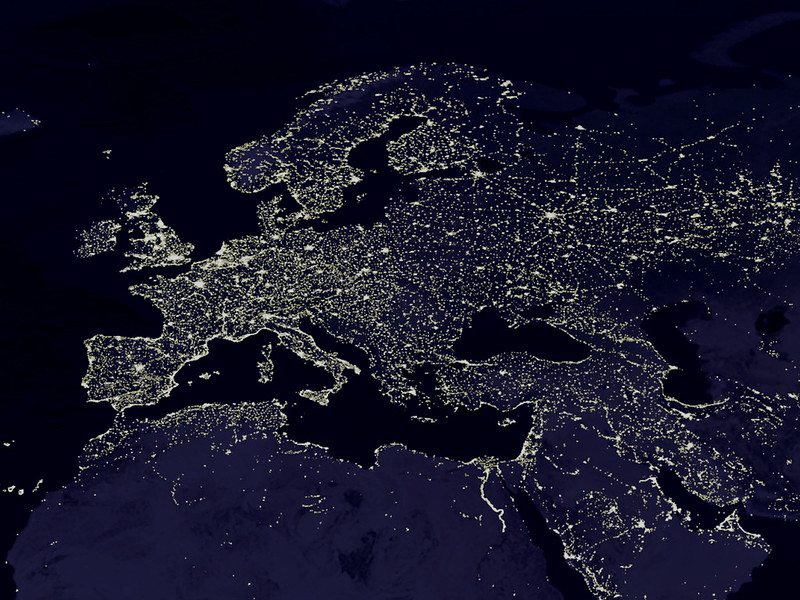
Europe from space. Image by woodleywonderworks via flickr.com. License: Creative Commons
Europeans send around a trillion dollars in cryptocurrencies to centralized and decentralized exchanges every year. One country is most important – and it is not Germany.
Europe is the largest cryptocurrency market. But only if you count Eastern Europe, including Russia. Central, Northern and Western Europe alone comes in third, after North America and Central and South Asia (including Oceania), while the EU region alone would do even worse.
This is according to Chainalysis’ new “Geography of Cryptocurrency” report. In this, the blockchain analyst assesses “crypto adoption” in 155 countries from mid-2022 to mid-2023. The index takes into account “hundreds of millions of transactions and 13 billion website views” to measure crypto activity. As an essential metric, he uses the values that are sent from the region to centralized, decentralized and P2P exchanges.
There is hardly any European country in the top 20. At the top are India, Nigeria and the United States. Ukraine, the first European country, comes in fifth place, Russia in 13th and Great Britain in 14th. You won’t find an EU country in the top 20.

The share of Central, Northern and Western Europe in global crypto flows. All graphics from Chainalysis’ report.
Nonetheless, with almost 18 percent of the volume received worldwide, Central, Northern and Western Europe is the third strongest crypto region in the world after North America (with 24.4 percent) and Central and South Asia (with 19.3 percent). If you include Eastern Europe, Europe as a whole is clearly at the top with 26.5 percent. However, we are concentrating here on Europe excluding Eastern Europe.
In total, the region received around a trillion dollars in crypto. Great Britain accounts for around a quarter of this, followed by Germany, Spain and France with a good 100 billion. Relevant amounts still flow to the Netherlands, Italy and Switzerland, the rest is distributed among many smaller countries.

As in North America, the share of “large institutional transactions” with more than $10 million is remarkably large here at almost 50 percent, while “consumer transactions” (under $10,000) barely account for a significant proportion.
In Europe in 2023, cryptocurrencies will be more than ever a matter for the wealthy and institutions. This trend can be observed worldwide, but is somewhat stronger in Europe than in most other regions.
Decentralized finance (DeFi), such as decentralized exchanges or lending platforms, are the most popular category in Europe. They take up almost 55 percent of the volume. DeFi, says Chainalysis, “plays a key role in the region’s crypto adoption over the past few years.” Although the activity is driven by consumers (retail), “the region’s institutions are opening up to DeFi.”

In most European countries, crypto flows fell, in some cases by more than 50 percent. However, they have tended to increase in Slovenia, Spain, France and Great Britain, with growth being driven primarily by decentralized exchanges.
Chainalysis then takes a closer look at Great Britain. With $250 billion in crypto assets received, the UK is well ahead of all other European countries and third globally behind India and the United States. This strong activity, Chainalysis notes, has not been constrained by regulation. In June 2023, a new law came into force that subjects “crypto assets” to existing financial regulation and authorizes the government to issue special rules for stablecoins.
This had an effect that can be seen on the charts: the incoming volume of stablecoins on centralized exchanges fell, while that of Bitcoin and Ether increased. However, stablecoins had previously experienced a phenomenal rise. In July 2022 they still accounted for almost 50 percent of the volume; By January 2023, the proportion had risen to 80 percent, and in June 2023 it was also more than 60 percent. The dominance of stablecoins remains unchallenged despite regulation.
Although Germany remains the most important crypto market in the EU region, the gap to the smaller economies of France and Spain has shrunk significantly. Measured in terms of population and GDP, Germany is likely to be far behind, while Spain in particular is coming out on top.
| Land | Resident | BIP | Crypto |
| Deutschland | 84,5 Mio. | 4.100 Mrd. USD | 116 Mrd. USD |
| France | 68 Mio | 3.000 Mrd. USD | 110 Mrd. USD |
| Spain | 50 | 1.400 Mrd. USD | 105 Mrd. USD |
The EU regulation MiCA, explains Chainalysis, will come into force in mid-2024 and standardize the licensing of the industry. But MiCA has already created a favorable environment for crypto innovations. The analyst explains this primarily using the example of France, where Paris is becoming a crypto hub and Société Générale, a major bank, has received a crypto license. Many international companies, such as Binance, Crypto.com and Circle, have set up their European headquarters in Paris.
Several large, traditional financial institutions in France are now turning to DeFi. As in the rest of Europe, the rule of thumb is: the larger the transaction, the more often it flows to DeFi instead of centralized exchanges. Institutional players in particular seem to trust smart contracts much more than centralized exchanges, while consumers continue to prefer centralized exchanges, presumably because they are simpler.

This trend is not new, but it is a bit depressing. Because DeFi makes it possible to break the power of institutions by breaking down all the walls that stand between the end user and financial services. DeFi makes it possible for everyone to exchange, borrow, lend, operate with various derivatives and, increasingly, enjoy traditional financial products such as government bonds without a middleman. But most end users apparently stick with their middlemen voluntarily. The decentralization of finance does not begin from below, but from above.
Source: https://bitcoinblog.de/2023/11/08/kryptoregion-europa-eine-sache-der-vermoegenden/


